Henro is an act of pilgrimage the whole of Shikoku while based at eighty-eight bill places in Shikoku. It is said that the eighty-eight temples are all old and have a history with the great master (Kobo-Daishi).
Kobo-Daishi was trained in Shikoku, the place of birth. Therefore, Kobo Daishi thought about his own way of life, sought for an ideal, prayed to convey it to as many people as possible, and made an effort.
In this article, we tell you the origin of the Shikoku pilgrimage and the attitude to take part in the pilgrimage tour.
What is the ‘Henro’?

In ancient times, Shikoku was a place far from the center of Japan, and it was a place of various trainings. The great master (Kobo Daishi, Kukai), who was born in Sanuki, Kagawa Prefecture, was also frequently trained in this area, and it was reported that he selected eighty-eight temples and created eighty-eight spirit places in Shikoku.
It is ‘Henro’ to pilgrimage the eighty-eight places relics that are the ruins of the Kobo Daishi.
The original Henro was centered on the monks. After that, with the rise of people’s faith in Kobo Daishi, it is said that many people from all over Japan were pilgrimage. And, as a place of connection of Kobo Daishi, it has developed as a sacred place that everyone wants to visit once.
About Kobo Daishi
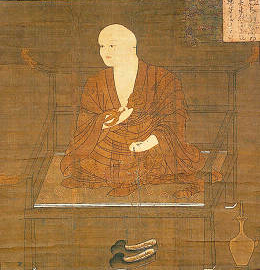
Image source : https://ja.wikipedia.org/wiki/%E7%A9%BA%E6%B5%B7#/media/File:Kobo_Daishi_(Taisanji_Matsuyama).jpg
Kobo Daishi was born in 774 in Sanuki “Byoubugaura” (currently Zentsuji City, Kagawa Prefecture). His young name is Mao, and it is said that he was a brilliant child.
When he was 15, he went up to Nagaokakyo to become a high-ranking official, and he entered university when he was 18 years old. At that time he was determined to be a Buddha’s way to go, under the great influence of the practitioners practicing Buddha in Yoshino and Mount Katsuragi.
And then, Kobo Daishi quit the university, overcoming the opposition around him.
After that, for the purpose of lawmaking, he was subjected to rigorous training at his birthplace of Mt Ishizuchi, Otakigoku, Murotozaki, etc.
After that, Kobo Daishi changed his name to “Kukai”, and went to Tang as a group of Chinese angels, and studied everything from monk Eka at Seiryu Temple in Chang’an.
After returning Japan, he was able to get permission to open Shingon-shu. He went to Mt. Koya and To-ji Temple, and wrote “Immediate Buddhahood righteousness” and “Secret Mandala and Tenjurism”, and worked on Buddhist altars, focusing on esoteric religion.
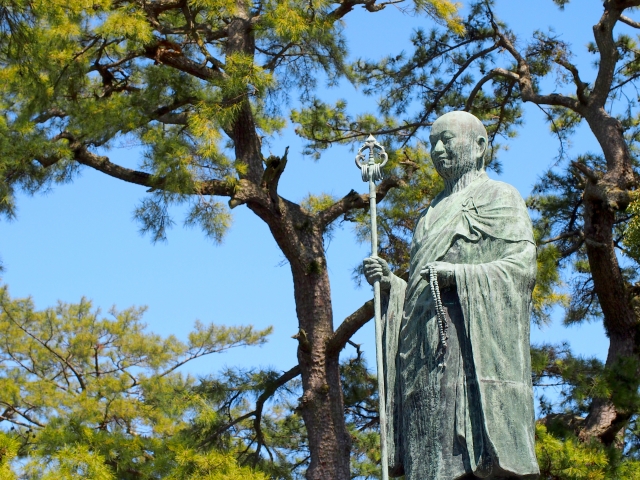
Kobo Daishi figure at Zentuji Temple
He also made great efforts to disseminate education and social projects, such as the construction of the first Japanese educational institution for the people of Japan, the construction of the “Shugeishuchi-in”, and the construction of the Manno-ike.
With the aim of allowing people to be happy and prosperous, and a way of life in which each of us can make full use of our abilities and talents, Kobo Daishi established its efforts at Mt. Koya in 835 at the age of 62. In honor of his achievements, he was awarded the Great Diploma of Kobo Daishi in 921 by emperor Daigo.
With him
When you are practicing pilgrimage, you are always with Kobo Daishi. In the case of the Shikoku pilgrim, as a symbol, the Kongo cane is considered to be Kobo Daishi itself. Even if there are multiple trainees, there are two individuals, individuals and a companion of Kobo Daishi.
Pilgrimage attitude
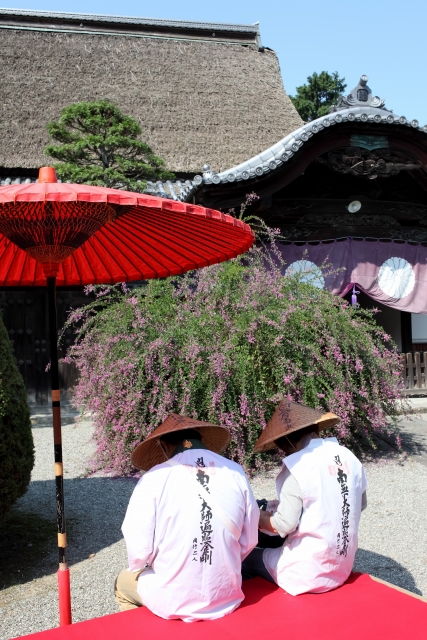
Henro is an act of pilgrimage the whole of Shikoku while based at eighty-eight bill places in Shikoku. All eighty-eight temples are said to have a long history and history with Kobo Daishi. Kobo Daishi was trained in Shikoku, the place of birth. So I thought about my own way of life, asked for an ideal, prayed to convey that to as many people as I did, and made an effort.
It is a pilgrimage to visit the trace of Kobo Daishi.
In addition, Henro is an act that seeks to change the mind. Even if we don’t think in depth, it is said that as we go around the temple, our mind will be transformed. It does not mean that you are required to read difficult books, interpret difficult scriptures, and cause ordinary people to suffer as much as they can.
However, the act of crawling in a sacred place is, even temporarily, an act of secession to the sanctuary, and there are various manners and rules. It is true that the pilgrimage will be deepened if you put in mind the significance that you put in your mind and action before you move on to the actual action. It is said that “prayer” is important in the pilgrimage since ancient times. Please pray carefully for the temple and Kobo Daishi during the pilgrimage.
Pilgrimage manners
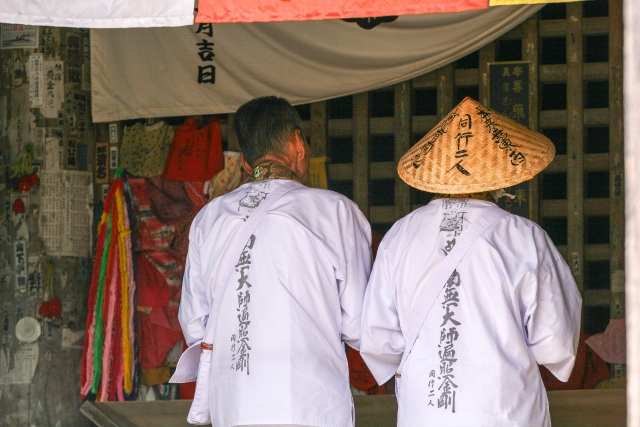
Each of the eighty-eight temples in Shikoku has the duality of being a pilgrimage temple and a temple of local pagans. In addition, the temples and the people in the vicinity have stern eyes that regard the pilgrim as a “trainer.”
As such, the facilities dedicated to pilgrimage are minimally equipped and have traditionally existed by the well-meaning of temples and locals until today. The facilities have been greatly improved now compared to old times, but please understand that point as it is not a place like a tourist destination.
・ Do not make the car classic or engine noise near the house in the early morning.
・ Don’t throw away paper waste and empty cans on the road.
Please follow the above manners and make a pilgrimage.
The people of Shikoku have called pilgrimage people “Ohenro-san”, have respected and have been warmly welcomed them. Because they have seen pilgrims devote themselves to the great master and have been trained hard. Please visit while keeping in mind the tense pilgrimage.
Eighty-eight temples
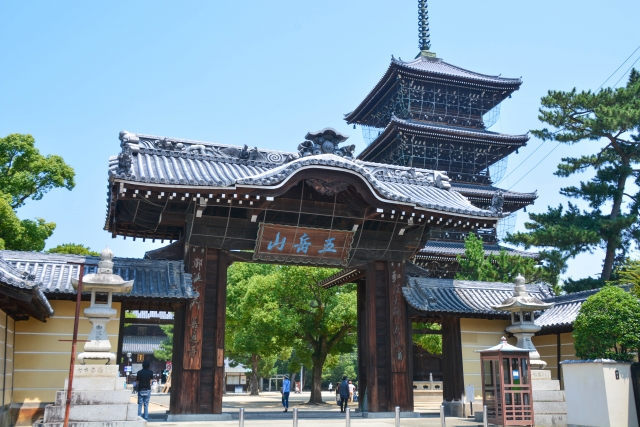
75 Zentsu-ji (Kagawa)
TOKUSHIMA
01 Ryōzen-ji (霊山寺)
02 Gokuraku-ji (極楽寺)
03 Konsen-ji (金泉寺)
04 Dainichi-ji (大日寺)
05 Jizō-ji (地蔵寺)
06 Anraku-ji (安楽寺)
07 Jūraku-ji (十楽寺)
08 Kumadani-ji (熊谷寺)
09 Hōrin-ji (法輪寺)
10 Kirihata-ji (切幡寺)
11 Fujii-dera (藤井寺)
12 Shōsan-ji (焼山寺)
13 Dainichi-ji (大日寺)
14 Jōraku-ji (常楽寺)
15 Awa Kokubun-ji (阿波国分寺)
16 Kannon-ji (観音寺)
17 Ido-ji (井戸寺)
18 Onzan-ji (恩山寺)
19 Tatsue-ji (立江寺)
20 Kakurin-ji (鶴林寺)
21 Tairyūji (太竜寺)
22 Byōdō-ji (平等寺)
23 Yakuō-ji (薬王寺)
KOCHI
24 Hotsumisaki-ji (最御崎寺)
25 Shinshō-ji (津照寺)
26 Kongōchō-ji (金剛頂寺)
27 Kōnomine-ji (神峰寺)
28 Dainichi-ji (大日寺)
29 Tosa Kokubun-ji (土佐国分寺)
30 Zenrakuji (善楽寺)
31 Chikurin-ji (竹林寺)
32 Zenjibu-ji (禅師峰寺)
33 Sekkei-ji (雪蹊寺)
34 Tanema-ji (種間寺)
35 Kiyotaki-ji (清滝寺)
36 Shōryū-ji (青竜寺)
37 Iwamoto-ji (岩本寺)
38 Kongōfuku-ji (金剛福寺)
39 Enkō-ji (延光寺)
EHIME
40 Kanjizai-ji (観自在寺)
41 Ryūkōji (竜光寺)
42 Butsumoku-ji (佛木寺)
43 Meiseki-ji (明石寺)
44 Daihō-ji (大宝寺)
45 Iwaya-ji (岩屋寺)
46 Jōruri-ji (浄瑠璃寺)
47 Yasaka-ji (八坂寺)
48 Sairin-ji (西林寺)
49 Jōdo-ji (浄土寺)
50 Hanta-ji (繁多寺)
51 Ishite-ji (石手寺)
52 Taisan-ji (太山寺)
53 Enmyō-ji (圓明寺)
54 Enmei-ji (延命寺)
55 Nankōbō (南光坊)
56 Taisan-ji (泰山寺)
57 Eifuku-ji (栄福寺)
58 Senyū-ji (仙遊寺)
59 Iyo Kokubun-ji (伊予国分寺)
60 Yokomine-ji (横峰寺)
61 Kōon-ji (香園寺)
62 Hōju-ji (宝寿寺)
63 Kichijō-ji (吉祥寺)
64 Maegami-ji (前神寺)
65 Sankaku-ji (三角寺)
KAGAWA
66 Unpen-ji (雲辺寺)
67 Daikō-ji (大興寺)
68 Jinne-in (神恵院)
69 Kannon-ji (観音寺)
70 Motoyama-ji (本山寺)
71 Iyadani-ji (弥谷寺)
72 Mandara-ji (曼荼羅寺)
73 Shusshakaji (出釈迦寺)
74 Kōyama-ji (甲山寺)
75 Zentsū-ji (善通寺)
76 Konzō-ji (金倉寺)
77 Dōryū-ji (道隆寺)
78 Gōshō-ji (郷照寺)
79 Tennō-ji (天皇寺)
80 Sanuki Kokubun-ji (讃岐国分寺)
81 Shiromine-ji (白峯寺)
82 Negoro-ji (根香寺)
83 Ichinomiya-ji (一宮寺)
84 Yashima-ji (屋島寺)
85 Yakuri-ji (八栗寺)
86 Shido-ji (志度寺)
87 Nagao-ji (長尾寺)
88 Ōkubo-ji (大窪寺)

